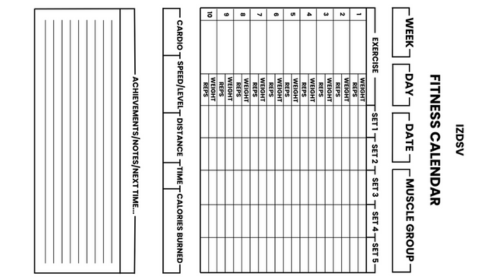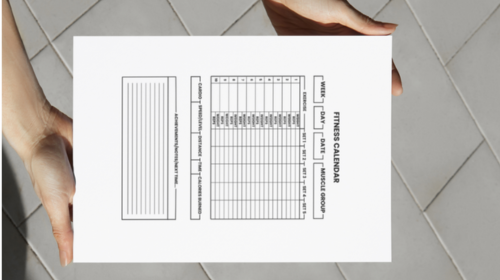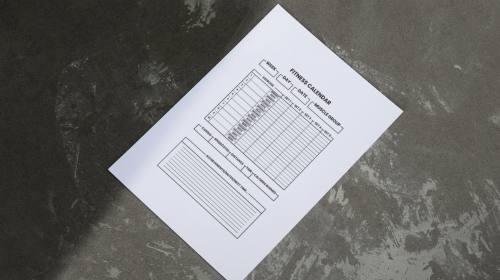Customizable Printable Fitness Planner – Achieve Your Goals Today!
What is a Customizable Printable Fitness Planner?
A customizable printable fitness planner is a personalized tool designed to help you track and manage your fitness goals. Unlike a regular planner, which focuses on general scheduling and organization, a fitness planner is specifically tailored to support your workout routines, nutrition, and overall health.
Key Differences Between Fitness Planners and Regular Planners
- Focus: Fitness planners prioritize fitness-related activities, while regular planners may have a broader scope.
- Content: Fitness planners often include features like workout logs, meal trackers, and progress charts.
- Customization: Fitness planners can be customized to suit individual needs and preferences, such as specific fitness goals or dietary restrictions.
Main Features of a Customizable Fitness Planner
- Workout tracking: Space to record workouts, including exercises, sets, reps, and weights.
- Progress tracking: Charts or graphs to monitor changes in strength, endurance, or body composition.
- Nutrition tracking: Sections for tracking meals, snacks, and calorie intake.
- Goal setting: Space to define fitness goals and track progress towards them.
- Habit tracking: Areas to monitor daily habits, such as hydration or sleep.
- Motivation trackers: Features to track mood, energy levels, or other motivational factors.
Why Customization is Important
- Personalization: A customized planner can better align with your unique fitness goals and preferences.
- Motivation: A personalized planner can be more motivating and engaging.
- Effectiveness: A planner that fits your lifestyle and habits is more likely to be effective in helping you achieve your fitness goals.
- Flexibility: Customization allows you to adapt the planner as your fitness journey evolves.
How Can a Fitness Planner Help You Achieve Your Goals?
A fitness planner can be a powerful tool for achieving your fitness objectives. Here’s how it can help:
Setting Specific Goals
- Clarity and focus: A planner allows you to define clear, measurable goals.
- Prioritization: You can prioritize goals based on importance and urgency.
- Breaking down goals: Large goals can be broken down into smaller, achievable steps.
Tracking Progress
- Motivation: Seeing your progress can boost motivation and keep you going.
- Accountability: Tracking progress helps you stay accountable to yourself.
- Identification of areas for improvement: You can identify areas where you need to adjust your approach.
Psychological Benefits
- Reduced stress: Focusing on fitness can reduce stress and improve mental well-being.
- Increased self-esteem: Achieving fitness goals can boost self-esteem and confidence.
- Improved mood: Regular exercise has been shown to improve mood and reduce symptoms of depression and anxiety.
- Sense of accomplishment: Reaching milestones can provide a sense of accomplishment and satisfaction.
What Should You Include in Your Fitness Planner?
A comprehensive fitness planner should include the following sections:
Workout Tracking
- Exercise log: Record exercises, sets, reps, and weights.
- Progress tracker: Monitor changes in strength, endurance, or body composition.
- Rest days: Schedule rest days to prevent overtraining.
Meal Planning
- Calorie tracking: Calculate daily calorie intake and expenditure.
- Macro and micro tracking: Track macronutrients (protein, carbohydrates, fats) and micronutrients (vitamins and minerals).
- Meal planning: Plan meals and snacks to meet your nutritional goals.
- Grocery list: Create shopping lists based on your meal plan.
Motivation and Inspiration
- Goals and affirmations: Set clear goals and write positive affirmations to motivate yourself.
- Progress photos: Take regular photos to track your physical changes.
- Success stories: Read inspiring stories of others who have achieved their fitness goals.
Additional Sections
- Sleep tracking: Monitor sleep quality and duration.
- Hydration tracking: Track water intake.
- Stress management: Implement stress reduction techniques.
- Notes and reflections: Write down thoughts, feelings, and challenges.
How to Customize Your Fitness Planner to Fit Your Needs
Personalizing your fitness planner is essential to make it a valuable tool for your journey. Here are some tips:
Design Elements to Personalize
- Colors: Choose colors that motivate and inspire you.
- Images: Include images related to your fitness goals or favorite workouts.
- Fonts: Select fonts that are easy to read and visually appealing.
- Layout: Experiment with different layouts to find one that suits your preferences.
Structuring Your Planner
- Daily: Track workouts, meals, and habits on a daily basis.
- Weekly: Review progress, set new goals, and plan workouts.
- Monthly: Assess overall progress, adjust goals, and celebrate achievements.
When Should You Start Using a Fitness Planner?
The best time to start using a fitness planner is whenever you’re ready. There’s no specific time of year that’s ideal for beginning your fitness journey. The most important thing is to start when you feel motivated and committed.
Impact of Starting Now
- Building momentum: Starting sooner can help you build momentum and establish healthy habits.
- Long-term benefits: Consistent effort now can lead to significant improvements in your health and fitness over time.
- Seasonal changes: Consider seasonal changes that may affect your motivation or goals (e.g., beach body goals for summer).
Signs to Reevaluate Your Routine
- Lack of progress: If you’re not seeing the results you expect, it may be time to reassess your routine.
- Plateaus: If you’ve reached a plateau in your fitness journey, consider changing things up.
- Injuries or pain: If you’re experiencing pain or discomfort, consult a healthcare professional and adjust your routine accordingly.
- Loss of motivation: If you’ve lost interest or motivation, it may be helpful to re-evaluate your goals and find new ways to stay engaged.
Why Is Consistency Key in Using Your Fitness Planner?
Consistency is crucial for achieving your fitness goals and making the most of your planner. Here’s why:
- Habit formation: Consistent use of your planner helps establish healthy habits and routines.
- Progress tracking: Regular updates allow you to track your progress and identify areas for improvement.
- Motivation: Seeing your progress can boost motivation and keep you going.
- Accountability: Consistent use helps you stay accountable to yourself and your goals.
How Often to Update Your Planner
- Daily: Update your workout planner daily to track workouts, meals, and other relevant data.
- Weekly: Review your progress, set new goals, and adjust your plan as needed.
- Monthly: Assess overall progress, celebrate achievements, and make any necessary changes in your fitness journal.
Strategies for Maintaining Consistency
- Set realistic goals: Break down large goals into smaller, achievable steps.
- Find a workout buddy: Having a workout partner can increase motivation and accountability in the gym.
- Mix up your routine: Avoid boredom by trying new exercises or activities.
- Reward yourself: Celebrate small victories and reward yourself for your progress.
- Stay positive: Focus on your accomplishments and avoid negative self-talk.
Celebrating Small Victories
- Acknowledge your progress: Take time to recognize and appreciate your achievements.
- Reward yourself: Treat yourself to something you enjoy, such as a new workout outfit or a relaxing activity.
- Share your successes: Celebrate with friends and family.



